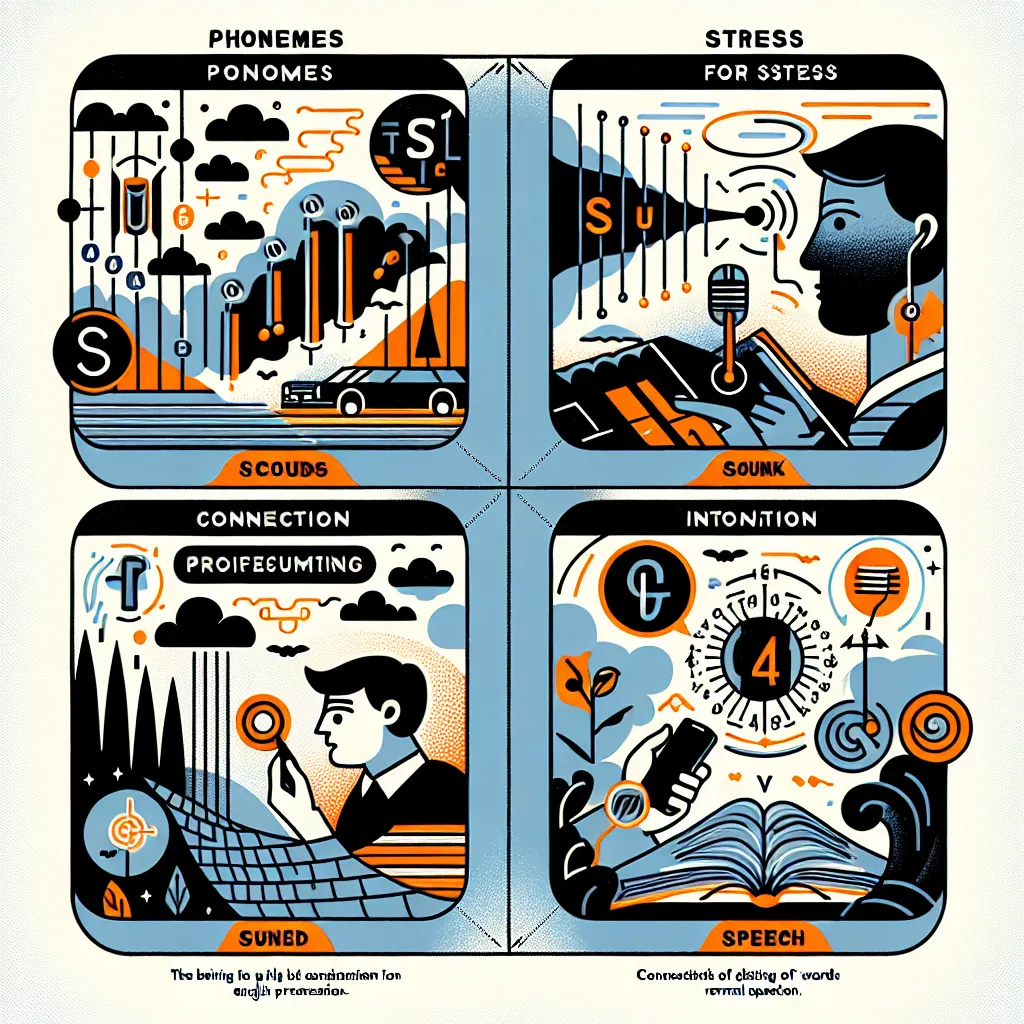Improving your English pronunciation is a crucial step in mastering the language. By incorporating daily routines into your pronunciation practice, you can make significant progress without drastically altering your schedule. This guide will provide you with effective strategies to enhance your pronunciation skills through everyday activities.
Understanding the Importance of Pronunciation
Proper pronunciation is essential for clear communication in English. It helps you avoid misunderstandings and increases your confidence when speaking. Many learners overlook pronunciation, focusing solely on vocabulary and grammar. However, good pronunciation is equally important for effective communication.
The Basics of English Pronunciation
English pronunciation involves several key elements:
- Individual sounds (phonemes)
- Stress patterns in words and sentences
- Intonation and rhythm
- Connected speech (how words link together)
Understanding these components is crucial for improving your overall pronunciation.
 English Pronunciation Basics
English Pronunciation Basics
Common Pronunciation Challenges
Learners often face challenges such as:
- Distinguishing between similar sounds (e.g., /θ/ and /ð/)
- Mastering word stress and sentence rhythm
- Adapting to regional accents and dialects
- Overcoming interference from their native language
By addressing these challenges through daily practice, you can significantly improve your pronunciation.
Incorporating Pronunciation Practice into Daily Routines
1. Morning Routine: Start Your Day with Pronunciation Exercises
Begin your day with a 5-10 minute pronunciation warm-up:
- Practice tongue twisters to improve articulation
- Read aloud from a newspaper or book
- Record yourself speaking and listen back critically
Example tongue twister: “She sells seashells by the seashore”
This routine helps train your mouth muscles and prepares you for speaking English throughout the day.
2. Commute Time: Listen and Repeat
Use your commute time effectively:
- Listen to English podcasts or audiobooks
- Repeat phrases or sentences you hear, mimicking the speaker’s pronunciation
- Focus on stress and intonation patterns
For instance, try the LearnEnglish podcast series for targeted pronunciation practice during your commute.
3. Lunch Break: Practice with Colleagues or Language Exchange Partners
If possible, use your lunch break for pronunciation practice:
- Have conversations in English with colleagues or language exchange partners
- Focus on pronouncing food-related vocabulary correctly
- Practice ordering food in English, paying attention to clear pronunciation
This real-life practice helps you apply pronunciation skills in everyday situations.
4. Evening Routine: Review and Reflect
End your day with a review session:
- Watch English TV shows or movies with subtitles
- Pay attention to the actors’ pronunciation and try to imitate it
- Record yourself reading a short passage and compare it with a native speaker’s version
For visual learners, incorporating strategies for learning English through visual media can be particularly effective.
Effective Methods for Pronunciation Improvement
1. Shadowing Technique
Shadowing involves listening to native speakers and repeating what they say in real-time. This method helps improve your pronunciation, intonation, and rhythm.
How to practice shadowing:
- Choose a short audio clip (30 seconds to 1 minute)
- Listen to it once without repeating
- Play it again, this time repeating the words as you hear them
- Focus on matching the speaker’s intonation and stress patterns
2. Minimal Pair Practice
Minimal pairs are words that differ by only one sound. Practicing these helps you distinguish between similar sounds in English.
Example minimal pairs:
- “ship” vs. “sheep”
- “bed” vs. “bad”
- “thin” vs. “tin”
Practice by listening to these words and trying to produce the correct sound.
3. Mirror Practice
Using a mirror while practicing pronunciation allows you to observe your mouth movements:
- Stand in front of a mirror
- Choose a challenging sound or word
- Pronounce it slowly, watching your lip and tongue movements
- Compare your movements with those of native speakers (use online videos for reference)
This visual feedback can help you correct your pronunciation more effectively.
Quick Tips for Pronunciation Improvement
- Use a pronunciation app daily (e.g., ELSA Speak, Pronunciation Coach)
- Record yourself speaking English and listen back critically
- Practice with a native speaker or tutor regularly
- Focus on one specific sound or aspect of pronunciation each week
- Use online resources like YouGlish to hear words pronounced in context
Remember, consistency is key. Even 10-15 minutes of daily practice can lead to significant improvements over time.
 Daily Pronunciation Practice
Daily Pronunciation Practice
Common Pronunciation Errors and How to Fix Them
1. Th-sound (/θ/ and /ð/)
Many learners struggle with the “th” sound, often substituting it with /s/, /z/, /t/, or /d/.
Fix: Place your tongue between your teeth and blow air out gently. Practice with words like “think,” “this,” “three,” and “breathe.”
2. Word Stress
Incorrect word stress can make your speech difficult to understand.
Fix: Use a dictionary to check the correct stress pattern. Practice stressing the right syllable by speaking louder and longer on that part of the word.
3. Silent Letters
English has many words with silent letters, which can be confusing for learners.
Fix: Make a list of common words with silent letters (e.g., “knife,” “listen,” “island”) and practice them regularly.
4. Vowel Sounds
English has many vowel sounds that may not exist in your native language.
Fix: Use the International Phonetic Alphabet (IPA) to learn the correct mouth positions for each vowel sound. Practice with minimal pairs focusing on vowels.
5. Consonant Clusters
Words with multiple consonants together (e.g., “strengths”) can be challenging.
Fix: Break down the word into smaller parts and practice each part separately before combining them.
Phonemic Chart and Commonly Mispronounced Words
The International Phonetic Alphabet (IPA) is a valuable tool for learning English pronunciation. Familiarize yourself with the English phonemic chart to understand the individual sounds in the language.
Here are 10 commonly mispronounced words related to daily routines, along with their correct pronunciations:
- Schedule – /ˈʃɛdjuːl/ (not /ˈskɛdjuːl/)
- Breakfast – /ˈbrekfəst/ (not /ˈbreɪkfæst/)
- Clothes – /kləʊðz/ (not /klɒθs/)
- Colleague – /ˈkɒliːɡ/ (not /ˈkɒliːɡjuː/)
- Comfortable – /ˈkʌmftəbəl/ (not /ˈkʌmfətəbəl/)
- Wednesday – /ˈwenzdeɪ/ (not /ˈwednəsdeɪ/)
- Evening – /ˈiːvnɪŋ/ (not /ˈiːvənɪŋ/)
- Routine – /ruːˈtiːn/ (not /ˈruːtiːn/)
- Sixth – /sɪksθ/ (not /sɪkθ/)
- Vegetable – /ˈvedʒtəbəl/ (not /ˈvedʒətəbəl/)
Practice these words regularly, paying close attention to the stress patterns and individual sounds.
Conclusion
Improving your English pronunciation through daily routines is an effective and efficient way to enhance your language skills. By incorporating the strategies and tips outlined in this guide, you can make steady progress without disrupting your daily schedule. Remember that consistency is key – even small amounts of daily practice can lead to significant improvements over time.
To further enhance your English learning experience, consider exploring ways to make English learning fun. This can help maintain your motivation and make the learning process more enjoyable.
We encourage you to share your experiences and ask questions in the comments section below. What daily routines have you found most effective for improving your pronunciation? How have these strategies impacted your overall English proficiency? Your insights could be valuable for other learners on their pronunciation journey.




